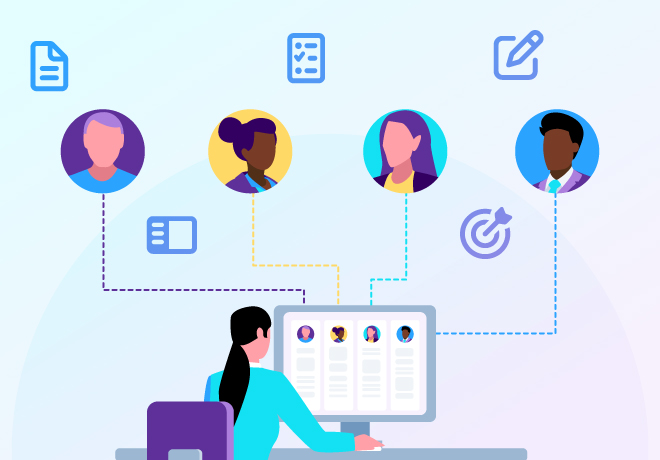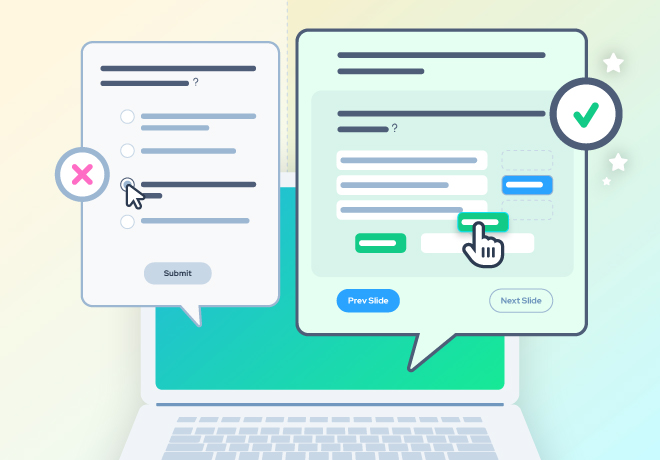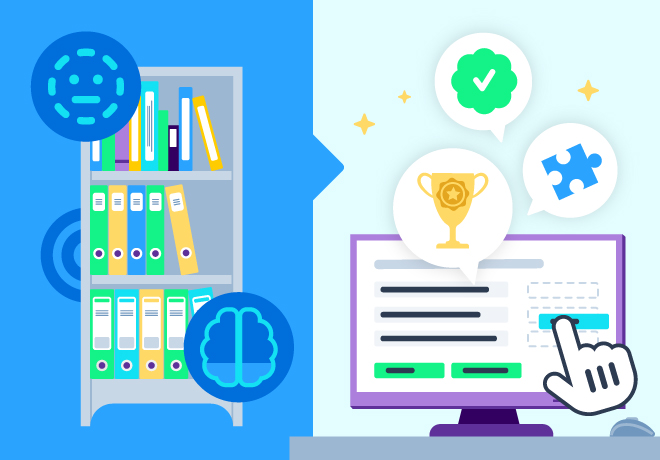
Everboarding: How to use online training to benefit your current employees

Related articles
Get valuable eLearning insights to your inbox.
Listen to Neovation’s Demystifying eLearning podcast generated with NotebookLM!
Listen to our podcast on your favorite platform!
No one expects a workplace incident to disrupt their day.
Picture this: Your coworker is opening a package at their desk next to yours. They get careless with the box cutter and accidentally slice through the palm of their hand. Blood is everywhere, but not spurting out in regular, crimson jets, so they likely missed the main artery. They should know better than to cut towards themselves, but you still need the first aid kit, and you need it now.
Do you know where it is?
You go to the last place you remember, but they’ve turned that location – the office supply room – into a temporary office for the summer interns. You know that you should know where they moved it – after all, everyone in the company should know the location of the first-aid kit, fire extinguishers, and emergency exits. At least they can’t change where the doors are!
By the time you return to your desk empty-handed, your other cube-dweller has found the first-aid kit, applied a dressing, and has your coworker holding their hand over their head to slow down the bleeding. You didn’t think you were gone that long, looking in the staff kitchen and the bathrooms, the new supply closet, and asking a few other people who shrugged and weren’t helpful at all.
You ask the hero of the hour how they remembered where the first aid kit was moved to. They look at you with surprise and answer, “It was in last week’s online training refresher on new policies and procedures now that we’re back in the office, post-pandemic. Didn’t you do your everboarding?”
Disclaimer: This has never happened to me.
Disclaimer double-down: Something like this has happened to all of us. That's why, in this article, we're going to go over:
- How everboarding is the natural continuation of training started by onboarding
- The custom and automated approach to everboarding
- What can go into an everboarding program, including ongoing HR admin supports, workplace health and safety, company culture-building upskilling, and reskilling
- How to ensure your everboarding program succeeds
Everboarding continues the training journey started by onboarding
When you’re a new hire, you know that there’s a lot that you need to learn. When you’re an established employee, there’s a lot to remember. The longer you are with a company or association, the more there is to know and to remember – and sometimes to relearn – because things change as companies change. And after coming through the past couple of years, there are so many changes in how we do so many things in our professional lives.
If you’re a training manager or administrator, it’s up to you to keep your team up to date and up to speed. You can’t rely on their memories of onboarding training that they may have taken years ago to fill in the gaps. That’s why a well-planned everboarding strategy should be the backbone of every company’s training framework.

Ongoing training is key in ensuring employee happiness and engagement, reducing the chance of your team leaving for what they may perceive as greener pastures elsewhere. People want to do well, and they need to be armed with all the information they need to do their jobs, navigate their corporate culture, and explore the pathways to career advancement. Think of them as each of the legs on a three-legged stool. If one is not there, a different length, or not as strong, that stool is not stable – and your employee will likely take a tumble into the arms of a new employer rather than settle in for the long term with you.
The customized and automated approach
Your onboarding is likely 60% general knowledge, which is needed by all employees in your organization, and 40% job or role specific (yes, your numbers may vary). Different roles require different training, and everyone needs to know the general broader scope of company information. Same with Everboarding.
A good learning management system or microlearning platform will allow you to tailor your training delivery based on the recipients' “Need to Know” factor. Again, some information will be general, and others will be role specific. You get to put the right training in front of the right people at the right time intervals to allow for the fast, easy recall of information as needed.
It’s true that not everyone will remember everything 100% of the time. There’s an entire branch of science devoted to how we learn, retain knowledge, and be trained to recall that information on demand. Here at Neovation, we dug deep into the study of learning and retention sciences when we were building our microlearning platform, OttoLearn. You can read the summary of some of our research in our white paper, The Cognitive Science Behind OttoLearn if you’re interested in the core theories behind learning retention.
The good news is that you don’t have to be an expert on cognitive science to leverage its principles. A good learning management system or microlearning platform should have some of those principles baked into its functionality.

See if your training technology allows you to schedule ongoing training by job title, role, assigned cohort, or group, re-enroll learners as needed in recurring training (quarterly, annually), and take them down a predefined learning path. This can make the customized delivery of your everboarding program so much easier.
What goes into an everboarding program?
Your onboarding program can provide you with an outline of what to add to your basic everboarding training. Look over everything that your new hires are responsible for learning, and start separating out the pieces, the nuggets of knowledge, that they will likely forget.
Ongoing HR administration supports
You walked them through a whole bunch of hiring paperwork and talked about vacation requests, expense reports, and other HR paperwork that may need updating if their family status changes. Add those to everboarding, scheduled to deploy at the times of the year when the average current employee might need them the most.
For example, a quick refresher on expense reports could be assigned in the last month of each quarter to help them tie up their expense submissions. Vacation request paperwork? Spring and fall, for summer and winter holiday travelers. Family status updates? Celebrate their work anniversary by reminding them to update any changes to their personal data.
Workplace health and safety
Anything to do with workplace health and safety – both general information and department-specific protocols - needs to be on a continual loop to ensure that the right information is top of mind in a crisis. This is a great topic for ongoing drip learning via a microlearning platform – where refresher training is delivered daily to ensure knowledge retention over time.
Company culture-building
Use everboarding to make your company culture sticky – in a good way. The larger the company, the harder it is to feel connected to everyone you work with – because you may not actually “work with” everyone in the same location. This is one of the challenges for hybrid or fully remote workers.
If you have a “coworker identification” component to your employee onboarding, to help a new hire get to meet everyone in their department, consider adding the entire company roster to your everboarding program – to encourage connections. No one wants to show up at the company picnic or holiday party and not know anyone outside of their own little corner of the office, plant, or break room. Ask your team to provide some “color commentary” to make it a rich “get to know you” experience. For example, new hires here at Neovation find out that I have two dogs, that I used to officiate weddings as a marriage commissioner, and am a Tarot enthusiast, as well as my title, how long I’ve been with the company, and what my role involves. There is a conversation starter somewhere, no matter who I run into! And I love knowing a bit more about my fellow Neovites. Makes it easy to kill – no strike that – INVEST time waiting for the online meeting to get underway.

Company culture is based on how your team understands your company’s Mission, Vision and Values statements. Keeping those front of mind helps keep your company culture strong. You can add so much to the culture-building component of your everboarding.
Upskilling
When employees take additional training that is aligned with the next stage of their career development, it boosts their performance in their current roles while improving their chances of a promotion or even a lateral move where their skills (old and newly acquired) can be of best benefit. Upskilling – or training for a future or expanded role – literally “upping” their skills” increases job satisfaction, engagement, and retention. You don’t want to lose a person that you’ve invested in – you want them to “stand and deliver” as the song says.
Your everboarding program will help you, as a training manager, find and eliminate knowledge gaps, but that’s just the tip of the training iceberg. The vast majority of people are curious and self-motivating; they want to learn more and grow their skills. You want to offer them opportunities to learn and grow. That might include soft skills and leadership training. We’ve all heard the parable of promoting the best widget maker to be the team leader, only to find out that both production and morale suffer – because they loved making widgets and have no skills to lead a team. Training can make that story have a happier ending.
Having a course catalog of available training topics and clear outlines of what is recommended or mandated to achieve the next level of success encourages employees to anticipate new skills their job will require and master them early.
Adding new skills to their toolkit is a key driver to employee happiness. Losing an employee is very expensive; replacing a worker costs about a third of that employee’s salary, according to the Work Institute’s 2020 Retention Report. That’s an average of $15K per employee departure – or more, depending on your company’s pay scale. Why do people leave? Employee feedback from many sources on this all say the same things – “lack of opportunities to advance or poor “career management.” That’s secret-squirrel code for training.

You want to retain your best employees and those who show potential. It’s frightening to realize that one in three hires leave within two years, according to HRDive. Some of that is the inevitable “poor fit” that doesn’t get discovered until someone is on the job, but the majority of that turnover is people being unhappy with the job they have taken. And that can be mitigated or prevented – the LinkedIn Workplace Learning Report found that 94% of employees are likelier to stay with an employer who invested in their skills and professional development.
Reskilling
If upskilling is focused on the future, then reskilling is about reclaiming the present moment. Reskilling has a couple of different facets to it – but with one goal – to help your employees manage change either in their roles or within the company as a whole. Let me give you some examples.
- You change equipment, and your team needs to learn how to use it. Increased automation in the workplace often means that teams need retraining on how to use their new tools, how to master their new processes, and how to maintain safety protocols around the new machinery.
- You put someone on a performance improvement plan, and they need to improve upon the skills they already have to remain employed.
- You want to move someone into a new role – more of a lateral move than a promotion, and they need to deepen their knowledge to make the move successfully. One could argue that this is upskilling, but depending on the role, it might also be classed as reskilling.
- You have a long-term employee that wants to revisit aspects of their work that may not be part of their day-to-day role, more of a refresher course on how to “do a thing” that perhaps has not been as integral a part of their job as may now be required. Reskill them.

My favorite quote about reskilling comes from Deloitte, “Reskilling has become a growth imperative for organizations, many of which have seen positions go unfilled for months or years for lack of the right talent to fill them.” It’s so easy to rely on your workers just to keep producing the work (whether it be widgets, lines of code, or sales calls) that many companies neglect the opportunity to train their current team to match their current and projected needs. You’ve got the eLearning tools – now maximize them!
Remember, training is part of working
It’s a challenge to make time for training – to feel that it is important enough to interrupt the work that just needs to get done every day, and there are never enough hours in the day to get everything done. If your company invests in ongoing training, the only way you will see ROI on that training investment is to create a culture of continuous learning that may need to be modeled from the top down.
At the very least, it needs to be strongly encouraged and supported by your team leaders, not as an afterthought, but as an integral part of every employee's job description after they complete their onboarding. I know – easier said than done, right?
Lean on learning strategies and technology to assist you
If you’re looking for ways for your everboarding program to excel, turn towards technology and use its benefits to your advantage. Tactics and concepts like adaptive training, personalized learning, and gamification, can add the right mix of interactivity, accountability, and fun that your employees will gravitate around. Become strategic with how you deliver everboarding through spaced repetition or by making use of performance supports. These topics and more are covered in our website's introductory guide to online training.
Keep this in mind. Having an ongoing culture of learning makes all the difference to the success of your everboarding program just as much as the technology you use to deliver it. Making it a manageable priority and part of the workweek is your key to everboarding success. Your team needs to see the value and feel that they have time to take the training courses you’re investing in creating. And that’s on you – they will do what you make them feel is the most important part of their job.
Training that is created and not taken is like a fancy eight-course dinner that is prepared and set out but never eaten. Your employees won't benefit from the training calories they need to consume to do their work better – which means greater productivity, higher employee satisfaction, lower employee churn, and – here’s what I always think is the most important – fewer health and safety incidents. Training saves lives, fingers, hands, toes, and feet… and makes your workplace safer and healthier.

While no one will die from slicing their hand with a box cutter opening a package (never cut towards yourself!), how much time was lost by at least three people in our little opening scenario – the victim, the hero, and the person who ran around like a chicken with their head cut off looking for the first aid kit? No widgets were made, no code was written, and no sales calls were placed. Two pieces of training – one on health and safety and one on office protocols may have been served up, but they weren’t consumed or digested.
Your team is hungry for ongoing training. It’s up to you to prepare, present, and ensure that high-value everboarding is served up on a regular basis to keep everyone satisfied and have fuel to burn to do their best work for you!

With 15+ years of online marketing and online learning experience, Susan loves to share insights about where these two ROI-building practices can intersect and complement each other for your business or organization.
Become part of our L&D community
We publish a new learning hub article — full of useful, practical topics — weekly.
Not sure where where you want to start? Jump into one of our recently published articles and see where it takes you!








-svg.svg)
-svg.svg)
-svg.svg)
-svg.svg)